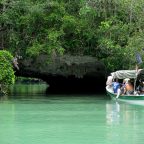
Just 20 miles north of where BP’s blown-out well spewed millions of gallons of oil into the sea, life appears bountiful despite initial fears that crude could have wiped out many of these delicate deepwater habitats.
Plankton, tiny suspended particles that form the base of the ocean’s food web, float en masse 1,400 feet beneath the surface of the Gulf of Mexico, forming a snowy-like underwater scene as they move with the currents outside the windows of a two-man sub creeping a few feet off the seafloor.
Crabs, starfish and other deep sea creatures swarm small patches of corals, and tiny sea anemones sprout from the sand like miniature forests across a lunar-like landscape illuminated only by the lights of the sub, otherwise living in a deep, dark environment far from the sun’s reach.
Scien...
Read More












Social Profiles